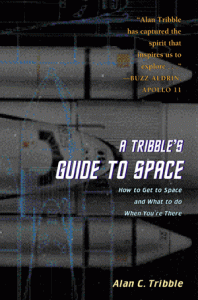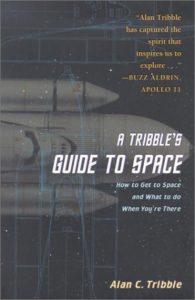

 Add To Collection
Add To CollectionFormat: Book: Hardcover
Language: English
Published by: Princeton University Press
ISBN-10: 0691050597
ISBN-13: 978-0691050591
Length: 224
Published On: 2000-10-15
Buy on Amazon.com
Buy On BarnsAndNoble.com
Buy On Bookshop.com
Buy On Books-A-Million.com
Wikipedia.org
Find on E-Bay
Space–the final frontier. It’s as little as fifty miles away, and yet it is considered one of the most dangerous and remote of places. Popular television shows such as Star Trek and movies such as Apollo 13 and October Sky have fired the imaginations of would-be explorers. Alan Tribble has worked on the design and development of dozens of spacecraft, including the Space Shuttle and the International Space Station. A Tribble’s Guide to Space is a how-to book that is firmly grounded in the realities of current state-of-the-art space engineering while tapping into the power of imagination that drives us to explore.
Alan Tribble offers a delightful guide to the nuts and bolts of space exploration, from how to get there to how to phone home and how to survive the harsh environment of space. Using examples from famous space missions, both factual and fictional, Tribble tackles fascinating real-world problems encountered in space exploration. Why do submarine hatches open inward and spacecraft hatches open outward? What do curveballs and satellites have in common? Why did Scotty, the chief engineer of the fictional USS Enterprise, always “need more power?” Why did the fire that destroyed Apollo I on the launch pad burn so furiously that no one could react fast enough to save the lives of the crew?
In answering these questions, Tribble examines getting to space, from the physics of motion to the practical implications of Einstein’s theory of relativity. He explores the basics of spaceships and starships, from power usage to navigation–all from the viewpoint of a spacecraft designer.
This book describes rocket science and more in a manner that captures the common excitement shared by anyone with an interest in space exploration. Armchair astronauts, engineers who work in a space company and anyone who has looked up at the sky and wondered how we will get there will find reading this book a wonderful and enlightening experience.
Other Editions:


 Add To Collection
Add To CollectionFormat: Book: Paperback
Language: English
Published by: Princeton University Press
ISBN-10: 0691027633
ISBN-13: 978-0691027630
Length: 192
Published On: 2002-09-01
Related Books
No related books found.







